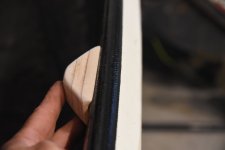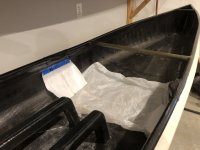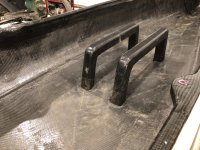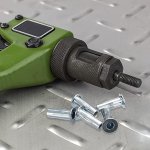Be advised, there are smaller threaded inserts that secure the seats to the composite side pods in many of the late model solos. Best to be careful with those as well.
-
Happy National Unicorn Day! 🦄
You are using an out of date browser. It may not display this or other websites correctly.
You should upgrade or use an alternative browser.
You should upgrade or use an alternative browser.
New Issue with my Swift portage yoke
- Thread starter Black_Fly
- Start date
Had to get Swift to issue a new hull number so I could register it in OH. Dumb requirement to register hand powered craft. Anyways, Swift’s old numbering system won’t comply with many state standards. No i gotta remove the old glue on plate
I'm not following why you would need a new hull ID number. We have to register canoes here as well. For out of state used canoes we either transfer the paperwork (if that state also required registration) or fill out a piece of paper stating that this canoe has never been previously registered.
I'm pretty sure the gal at the courthouse would flip out if I told her I removed the original HID and installed a new one.
Alan
I wrote about this situation over on the WCHA forum:
“I just found out while trying to register my 1965 Old Town WC canoe that Ohio now requires that boats without a 12 digit HIN (hull inspection number) be assigned one before they can be licensed. The original original serial numbers are not sufficient. This means calling and setting up an appointment with a license bureau that handles watercraft, taking the boat to their location and getting it physically inspected…If you want a small Alternative Registration sticker and the boat previously had the Traditional Registration stamps with gigantic…numbers, that requires an extra step of having the bureau call in to ODNR Watercraft while you're at their location to make the switch.”
Apparently they will send out a small badge with the new HIN that will need to be attached to the canoe.
Sorry to hear about your boat issues Black Fly…
Rob
“I just found out while trying to register my 1965 Old Town WC canoe that Ohio now requires that boats without a 12 digit HIN (hull inspection number) be assigned one before they can be licensed. The original original serial numbers are not sufficient. This means calling and setting up an appointment with a license bureau that handles watercraft, taking the boat to their location and getting it physically inspected…If you want a small Alternative Registration sticker and the boat previously had the Traditional Registration stamps with gigantic…numbers, that requires an extra step of having the bureau call in to ODNR Watercraft while you're at their location to make the switch.”
Apparently they will send out a small badge with the new HIN that will need to be attached to the canoe.
Sorry to hear about your boat issues Black Fly…
Rob
FYI, I did find the Swift video in question, titled 'Video Owner's Manual - Solo Canoes'. In the video, owners are cautioned to lift the canoe with hands on the gunnels AND yoke (not just the yoke), to avoid transporting the canoe yoke attached, and to remove the detachable seats. It seemed as though the concern was about losing parts in transit as well. Another contributing factor to this failure might be that the yoke was a home-made version (see earlier Canoetripping thread 'Advice on Removable Yoke Project). The yoke had threaded inserts in it which had to be oriented in such a way that the threads would meet up with the threads in the gunnel inserts for the bolt to engage. I cannot imagine how one could truly accomplish that and still ensure that the yoke was drawn up tight to the gunnels (as Alan Gage pointed out in the thread). It is possible that the inserts have been stressed for some time and eventually failed in transit from shock and vibration.
I wrote about this situation over on the WCHA forum:
“I just found out while trying to register my 1965 Old Town WC canoe that Ohio now requires that boats without a 12 digit HIN (hull inspection number) be assigned one before they can be licensed. The original original serial numbers are not sufficient.
I can certainly see this being the case with an old hull that doesn't follow the current HIN guidelines. I would not think that would be so in this case however with a Swift that's only a few years old.
Alan
I was thinking about @Alan Gage's solution again, while looking at the useful picture provided by @M Clemens, and will offer a friendly amendment to Alan's idea:

How about using melted candle wax to carefully prefill the lower threaded portion of the insert with wax to protect the threads from epoxy, and then fill the upper flanged portion of the anchor-insert with epoxy so that it will flood into those squashed flanges. You could either drill out that upper level of epoxy and/or insert a little cylinder of foam before it cures (like backer rod) to displace the epoxy out of the center cylinder, where the bolt will be installed. The candle wax could be gouged out easily thereafter.
To improve the connection further, a slightly compressible foam or rubber gasket, cut to fit around the insert anchor, but between the temporary yoke and gunwales, might improve the yoke's bearing against the gunwales on either side of the anchor to take up some of the "slop."
If it was mine I'd be temped to pour it full of epoxy and then thread a bolt into the threads that was really well waxed or wrapped with teflon tape.
After the resin cures the bolt will hopefully thread out and things would hopefully be solid again
How about using melted candle wax to carefully prefill the lower threaded portion of the insert with wax to protect the threads from epoxy, and then fill the upper flanged portion of the anchor-insert with epoxy so that it will flood into those squashed flanges. You could either drill out that upper level of epoxy and/or insert a little cylinder of foam before it cures (like backer rod) to displace the epoxy out of the center cylinder, where the bolt will be installed. The candle wax could be gouged out easily thereafter.
To improve the connection further, a slightly compressible foam or rubber gasket, cut to fit around the insert anchor, but between the temporary yoke and gunwales, might improve the yoke's bearing against the gunwales on either side of the anchor to take up some of the "slop."
I have the same set-up on my new Keewaydin, and it appears to be robust. I would wager to say it received some abuse from the previous owner.
Bob
Bob
Agreed. Swift has been using 12 digits as long as I can remember. Should be good in any state. Is it possible the SWI prefix was not included in the correspondence?I can certainly see this being the case with an old hull that doesn't follow the current HIN guidelines. I would not think that would be so in this case however with a Swift that's only a few years old.
Alan
View attachment 146140
Is this true? That sounds so stupid!...Somewhere on the Swift website, maybe in one of the videos, it says to always remove the detachable yoke before driving with the canoe on the car...
I mean, you will need your yoke when carrying the canoe to the car. I wouldn't want to put my canoe down on the road or parking lot surface to remove the yoke before lifting it up again to put it on the roof rack. Or, once the canoe is on the roof, removing the yoke is fiddly and tight and will put scratches on the roof of the car. Not only that, but removing the yoke from the canoe greatly increases the chances that you will forget to bring it the next time you are going anywhere. Aren't Swift supposed to be the greatest thing out there, the price of their boats certainly suggests so.
Last edited:
Is this true? That is so stupid!
I mean, you will need your yoke when carrying the canoe to the car.
I would guess the vast majority of people do not use their removable portage yoke when carrying the canoe to/from the car, especially these light weight solos. The only time I ever use mine is when I'm on a trip that requires portaging, otherwise it stays in storage. Solo canoes are easy enough to carry short distances without it.
It also seems illogical to want to leave a removable yoke on your canoe during transport as I'd be worried about fasteners coming loose and arriving at the destination to find the yoke gone.
While I'm not a big fan of the method Swift is using with the inserts I also haven't seen very many complaints about them coming loose so it must work pretty well overall.
Alan
If you have a very light canoe I can see how you wouldn't need the carrying yoke. But isn't this system the same for all their boats with removable yokes, tandems as well?I would guess the vast majority of people do not use their removable portage yoke when carrying the canoe to/from the car, especially these light weight solos. The only time I ever use mine is when I'm on a trip that requires portaging, otherwise it stays in storage. Solo canoes are easy enough to carry short distances without it.
It also seems illogical to want to leave a removable yoke on your canoe during transport as I'd be worried about fasteners coming loose and arriving at the destination to find the yoke gone.
While I'm not a big fan of the method Swift is using with the inserts I also haven't seen very many complaints about them coming loose so it must work pretty well overall.
Alan
Maybe it works, it's just not impressive design from Swift.
Last edited:
If you have a very light canoe I can see how you wouldn't need the carrying yoke. But isn't this system the same for all their boats with removable yokes, tandems as well?
I had assumed that tandems would not be equipped with removable yokes but I just looked on their site and see their "combi" tandems (with center mounted seat for solo paddling) do have the option for a center mounted yoke.
But they're heaviest combi tandem layup (Keewaydin 17 in Expedition Kevlar) is still only 45 pounds which I would just shoulder or hold overhead to and from the car.
Alan
With acknowledgment that Swift does outline disclaimers and user guidance that recommends a remarkably circumscribed usage of this temporary yoke…. I too would hope that a “tripping” grade yoke could at least weather a car ride.
I bet we see improvements to the attachment in subsequent design iterations. Swift seems to do too nice a job not to make these a bit more robust in the future.
I bet we see improvements to the attachment in subsequent design iterations. Swift seems to do too nice a job not to make these a bit more robust in the future.
- Joined
- Jan 7, 2016
- Messages
- 928
- Reaction score
- 838
I’m not the sharpest knife in the drawer, being dumb is like being dead, everybody knows it but you. Having said that, I am however, somewhat observant. I think the Cosmos is trying to tell Black _Fly something. He has had more misfortune than the rest of us combined.
Can’t it just be drilled out and replaced?
I've had at least 12 solo canoes since the early 80s.
NONE of those canoes has ever had a permanent portage yoke because such a yoke would interfere with a properly positioned central seat. Hence, I've ALWAYS had a detachable yoke of some kind for all of these solo canoes, including my most recent Swift Keewaydin 15 with the same kind of screw-in yoke as Black Fly. In 40+ years I've NEVER driven my vehicle even short distances with a detachable yoke attached to the cartopped canoe. That's always seemed foolishly risky.
Composite solo canoes are usually light enough to carry easily from a vehicle to most put-ins. Even my ninth decade decrepit skeleton can carry my 28 lb. Swift. In the rare event that I have carried a solo canoe with a detachable yoke to my vehicle and put it on the bars that way, it's easy to detach most screw/clamp yokes while they are on the cartop bars, unless those bars have virtually no clearance above the roof. You just have to walk around both sides and loosen the screw mechanisms, slightly lifting up each side as you are unscrewing if the roof clearance is low.
This is all so obvious and easy.
NONE of those canoes has ever had a permanent portage yoke because such a yoke would interfere with a properly positioned central seat. Hence, I've ALWAYS had a detachable yoke of some kind for all of these solo canoes, including my most recent Swift Keewaydin 15 with the same kind of screw-in yoke as Black Fly. In 40+ years I've NEVER driven my vehicle even short distances with a detachable yoke attached to the cartopped canoe. That's always seemed foolishly risky.
Composite solo canoes are usually light enough to carry easily from a vehicle to most put-ins. Even my ninth decade decrepit skeleton can carry my 28 lb. Swift. In the rare event that I have carried a solo canoe with a detachable yoke to my vehicle and put it on the bars that way, it's easy to detach most screw/clamp yokes while they are on the cartop bars, unless those bars have virtually no clearance above the roof. You just have to walk around both sides and loosen the screw mechanisms, slightly lifting up each side as you are unscrewing if the roof clearance is low.
This is all so obvious and easy.
Did you ever reach out to Swift? I know he has had to repair at least two others. Even if you don't want to ship it back there, he could provide some guidance on their process.Can’t it just be drilled out and replaced?
Spoke to swift. Ordered a couple replacements. They just rip them out then repair the gunwales. I’m thinking about a deep hole saw or a thin hack saw blade to get under the flange.
Not sure drilling them out would work. They might spin, and I’d give up the threads to use for upward pressure.
Not sure drilling them out would work. They might spin, and I’d give up the threads to use for upward pressure.
Similar threads
- Replies
- 4
- Views
- 978




